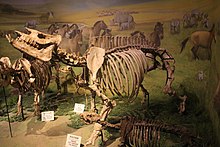Acerorhinus is an extinct genus of rhinocerotid of the tribe Aceratheriini endemic to Asia from the Miocene, living from 13.6 to 7.0 mya existing for approximately 6.6 million years.[2]
| Acerorhinus Temporal range: Serravallian-Messinian,
| |
|---|---|

| |
| Skeletal mount, Tianjin Natural History Museum | |
| Scientific classification | |
| Domain: | Eukaryota |
| Kingdom: | Animalia |
| Phylum: | Chordata |
| Class: | Mammalia |
| Order: | Perissodactyla |
| Family: | Rhinocerotidae |
| Subfamily: | †Aceratheriinae |
| Genus: | †Acerorhinus Kretzoi, 1942 |
| Type species | |
| †Acerorhinus zernowi Borissiak, 1914
| |
| Species[1] | |
| |
Among other locations, well-preserved Acerorhinus skull specimens have been found at Kerassiá in North Eubonea, Greece.[3]
Taxonomy
editAcerorhinus was named by Kretzoi (1942). Its type is Aceratherium zernowi. Originally, many species in this genus including A. zernowi were assigned to Chilotherium. It was assigned to Aceratheriini by Kaya and Heissig (2001); and to Aceratheriini by Antoine and Saraç (2005).[4]
Description
editAcerorhinus had very short legs, more like Teleoceras than other Aceratherines. While most other Aceratherines were grazers, Acerorhinus had brachyodont teeth which indicate a preferences for browsing.[5]
Like other Aceratherines, it was hornless and had tusk-like incisors.
References
edit- ^ "Acerorhinus". Biolib.
- ^ "Acerorhinus". Fossilworks.
- ^ Athanassiou, Athanassios (September 2014). "A new hornless rhinoceros of the genus Acerorhinus (Perissodactyla: Rhinocerotidae) from the Upper Miocene of Kerassiá (Euboea, Greece), with a revision of related forms". Palaeontographica Abteilung A. 303 (1–3): 23. Bibcode:2014PalAA.303...23A. doi:10.1127/pala/303/2014/23 – via Science Citation Index.
- ^ P.-O. Antoine and G. Saraç. 2005. Rhinocerotidae from the late Miocene of Akkasdagi, Turkey. Geodiversitas 27(4):601-632
- ^ Agustí, Jordi; Antón, Mauricio (2002). Mammoths, Sabertooths, and Hominids: 65 Million Years of Mammalian Evolution in Europe. Columbia University Press. p. 162. ISBN 9780231116411.